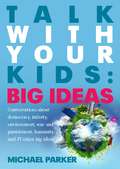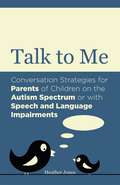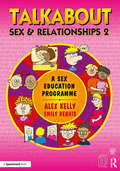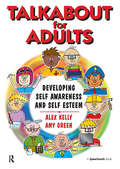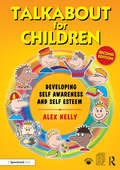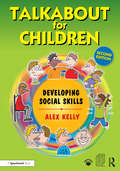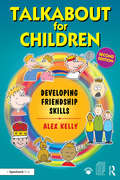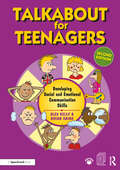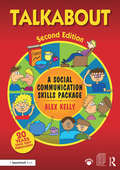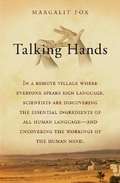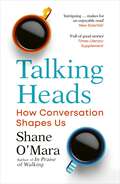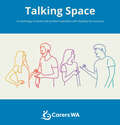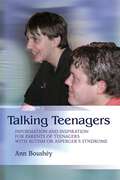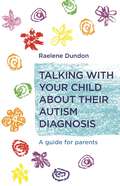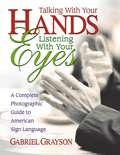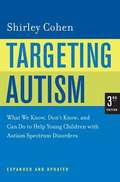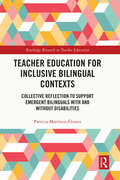- Table View
- List View
Talk With Your kids: Big Ideas
by Michael ParkerTalk With Your Kids: Big Ideas is the second in the Talk With Your Kids series by Michael Parker. Once again Michael stirs up all of those tricky questions that parents often avoid such as 'what is infinity?' 'What is democracy?' Or even 'can I own a gun?' Big Ideas has over 75 conversations for parents to have with their children to try and tackle those large questions about life and the universe. Michael Parker promotes the use of the questions for a platform fordiscussion with children, which will engage them more than a simple read of a book. Michael uses varied formatting such as: the use of multiple choice questions, visual scenarios or open ended questions to engage both children and parents alike and stimulate discussion. Talk With Your Kids: Big Ideas is a tool for parents to help their children understand aspects of the world that they might not even understand in the first place.
Talk to Me: Conversation Strategies for Parents of Children on the Autism Spectrum or with Speech and Language Impairments
by Heather JonesIf your child finds talking to people a struggle, this is the book to get the conversation started. In this hands-on guide, Heather Jones offers practical advice, born of experience with her own son, which will help you teach your child the principles of communication. Full of strategies and examples, it shows how you can allay fears, build confidence and teach your child to enjoy conversation. Once a child gets used to talking with other people, many life skills can develop more easily as they grow up - from making friends and shopping for themselves, to being interviewed and eventually getting a job. This handy book provides guidance and inspiration to parents, teachers and anyone else who cares for a child who finds language and comprehension difficult.
Talk to Me: Conversation Strategies for Parents of Children on the Autism Spectrum or with Speech and Language Impairments
by Heather JonesThe award-winning book on engaging in more meaningful conversations with your child on the Autism spectrum.If your child finds talking to people a struggle, this is the book to get the conversation started.In this hands-on guide, Heather Jones offers practical advice, born of experience with her own son, which will help you teach your child the principles of communication. Full of strategies and examples, it shows how you can allay fears, build confidence and teach your child to enjoy conversation. Once a child gets used to talking with other people, many life skills can develop more easily as they grow up - from making friends and shopping for themselves, to being interviewed and eventually getting a job.This handy book provides guidance and inspiration to parents, teachers and anyone else who cares for a child who finds language and comprehension difficult.(P)2017 Hodder & Stoughton Limited
Talkabout Sex and Relationships 2: A Sex Education Programme (Talkabout)
by Alex Kelly Emily DennisTalkabout Sex & Relationships 2 is a comprehensive toolkit for all therapists, educators and support staff who deliver sex education to people with special needs. It is intended primarily to support groupwork but activities can be easily adapted to suit the needs of individuals with varying abilities. The resource emphasises the importance of being well informed in regards to the physical, interpersonal and emotional aspects of sex; including body awareness, consent, sexual health and guidelines for a healthy sexual relationship. It is packed with practical activities which are designed to open up discussion around sensitive issues in a fun, informative and non-judgemental way. Each activity comes with guidance for practitioners on how to prepare for and delivery the sessions. Features include: guidelines to assess the suitability of students for the programme visually appealing and engaging activities with full colour illustrations photocopiable activities which can also be downloaded for free on the accompanying website template letters for parental permission in delivering the sessions This toolkit is the second in a two volume set, the first of which focuses on relationships. Created by Alex Kelly and Emily Dennis as part of the bestselling Talkabout series, this publication constitutes the most complete and trustworthy set of resources available for groupwork focussing on sex and relationships for people with special needs.
Talkabout for Adults (Talkabout)
by Alex Kellyalkabout Adults is a practical resource to help therapists or support staff to develop self-awareness and self-esteem in adults. It has been particularly aimed at adults with an intellectual disability (learning disability) or older children with special needs. It has been adapted from the Talkabout for Children: developing self-awareness and self-esteem book to be suitable for an older audience. This means that some of the activities are almost identical but a number of them have been adapted to be more appropriate. There are also some new activities such as the 'A book about me.' which enables the adults to make up a book over the course of the sessions that will summarise some keys personal facts. This can work well as an addition to a communication passport or equivalent, or can stand alone as an alternative. Talkabout for Adults is a stand-alone resource with approximately a year's worth of activities to develop self-awareness and self-esteem. It has 50 activities to do with adults and it has been successfully piloted at Speaking Space. It includes: a short assessment of self-awareness and self-esteem; a year's worth of work on self-awareness and self-esteem including 50 activities and some worksheets; practical suggestions to make your group work successful including 25 group cohesion activities, a plan for intervention, and forms for monitoring and evaluation. This resource continues to use the Talkabout hierarchical approach to teaching skills, that is, basic self-awareness skills are taught prior to more complex skills such as social skills and friendship skills. This also means that this resource is designed to be used logically from topic 1 through to topic 8. Most of the activities are more suited to working in a group setting but some of them can be adapted for one-to-one work. Alex Kelly is a speech and language therapist who specialises in working with children who have low self esteem, and difficulty with their social skills and friendship skills. She spent 23 years working as a speech and language therapist in the NNHS but now runs her own company - Alex Kelly Ltd. She provides social skills training and consultancy to schools and organisations across the UK and overseas. Her company also provides speech and language therapy in a number of special schools in eh south of England.
Talkabout for Children 1: Developing Self-Awareness and Self-Esteem (Talkabout)
by Alex KellyTalkabout for Children: Developing Self-Awareness and Self-Esteem is a bestselling professional workbook supporting educators and therapists who deliver social and relationship skills groups for children with social, emotional or behavioural difficulties. Self-awareness and self-esteem is an essential prerequisite to developing social skills and so this book is an excellent first step to any social skills programme. This resources creates the foundation of the Talkabout heirachy, where self-awareness comes before non-verbal skills and non-verbal comes before verbal, with assertiveness coming last. Resources include: an assessment framework planning and evaluation forms a three-term intervention plan for schools over 40 structured activity sessions focussing on self-awareness and self-esteem all the supplementary handouts and images needed to deliver the sessions. This second edition is presented with full-colour illustrations and handouts, and includes a new introduction by Alex Kelly reflecting on her own experiences of using the resources since they were first developed.
Talkabout for Children 2: Developing Social Skills (Talkabout)
by Alex KellyTalkabout for Children: Developing Social Skills is a bestselling professional workbook supporting educators and therapists who deliver social and relationship skills groups for children with social, emotional or behavioural difficulties. Social competence is an essential aspect of our quality of life and this resource will help to develop these skills in young children. This resources creates the second level of the Talkabout heirachy, where self-awareness comes before non-verbal skills and non-verbal comes before verbal, with assertiveness coming last. Resources include: an assessment framework planning and evaluation forms a three-term intervention plan for schools over 60 structured activity sessions focussing on social skills all the supplementary handouts and images needed to deliver the sessions. This second edition is presented with full-colour illustrations and handouts, and includes a new introduction by Alex Kelly reflecting on her own experiences of using the resources since they were first developed.
Talkabout for Children 3: Developing Friendship Skills (Talkabout)
by Alex KellyTalkabout for Children: Developing Friendship Skills is a bestselling professional workbook supporting educators and therapists who deliver social and relationship skills groups for children with social, emotional or behavioural difficulties. This resources creates the final level of the Talkabout heirachy, where self-awareness comes before non-verbal skills and non-verbal comes before verbal, with assertiveness coming last. Resources include: an assessment framework planning and evaluation forms a three-term intervention plan for schools over 25 structured activity sessions focussing on friendship skills all the supplementary handouts and images needed to deliver the sessions. This second edition is presented with full-colour illustrations and handouts, and includes a new introduction by Alex Kelly reflecting on her own experiences of using the resources since they were first developed.
Talkabout for Teenagers: Developing Social and Emotional Communication Skills (Talkabout)
by Alex Kelly Brian SainsTalkabout for Teenagers is a bestselling professional workbook supporting educators and therapists who deliver social and relationship skills groups for older children and young adults with social, emotional or behavioural difficulties. It is a complete group work resource that offers a hierarchical approach, with ready-made material to assist teaching social and relationship skills specifically to older children and young adults. Resources include: an assessment framework planning and evaluation forms 37 structured session guides focussing on self-awareness and self-esteem, body language, conversational skills, friendship skills and assertiveness all the supplementary handouts and images needed to deliver the sessions. This second edition is presented with full-colour illustrations and handouts, and includes a new introduction by Alex Kelly reflecting on her own experiences of using the resources since they were first developed.
Talkabout: A Social Communication Skills Package (Talkabout)
by Alex KellyThis core Talkabout manual is a practical resource essential for Speech and Language Therapists and other professionals who need to help people with special needs develop social skills. Over 60 activities form an extensive, structured social skills programme that can easily be adapted for use with children, adolescents and adults. Written by bestselling author and practising Speech and Language Therapist, Alex Kelly, this book sits at the centre of an internationally renowned series of resources supporting social skills. Contents include: a social skills assessment and intervention planning tool to help you identify the best way forward for each client or group over 60 activities focussing on body language, conversation and assertiveness 25 group cohesion activities to help you facilitate well-run, productive group sessions a wealth of handouts supporting the activities that can be freely downloaded and printed. This updated second edition of Talkabout sits alongside Talkabout for Teenagers and Talkabout for Adults, as well as three titles published for children (Developing Self Awareness and Self Esteem, Developing Social Skills and, Developing Friendship and Skills).
Talking Books: Pioneering and Beyond
by Marilyn Lundell MajeskaAlthough libraries had been finding ways to serve blind patrons as early as the late nineteenth century, the passage of the Pratt-Smoot Act in 1931 was a game-changer. Congress appropriated funds to provide books for blind adults, and the National Library Service for the Blind and Physically Handicapped was established. The five decades after Pratt-Smoot saw many technological developments in recording machines and techniques, some coming hand in hand with innovations in the music industry: from record players, to reel-to-reel tapes, to cassette players. Inevitably, the "talking books" program would always be a compromise between the best possible product and the limitations of what was practical and economically feasible. Author Majeska synthesizes information from interviews and old files to compile a detailed history of talking books from 1932 to 1988--before computers changed the whole scene.
Talking Hands: What Sign Language Reveals About the Mind
by Margalit Fox<P>Imagine a village where everyone "speaks" sign language. Just such a village - an isolated Bedouin community in Israel with an unusually high rate of deafness - is at the heart of Talking Hands: What Sign Language Reveals About the Mind. There, an indigenous sign language has sprung up, used by deaf and hearing villagers alike. It is a language no outsider has been able to decode, until now. <P>A New York Times reporter trained as a linguist, Margalit Fox is the only Western journalist to have set foot in this remarkable village. In Talking Hands, she follows an international team of scientists that is unraveling this mysterious language. <P>Because the sign language of the village has arisen completely on its own, outside the influence of any other language, it is a living demonstration of the "language instinct," man's inborn capacity to create language. If the researchers can decode this language, they will have helped isolate ingredients essential to all human language, signed and spoken. But as Talking Hands grippingly shows, their work in the village is also a race against time, because the unique language of the village may already be endangered. <P>Talking Hands offers a fascinating introduction to the signed languages of the world- languages as beautiful, vital and emphatically human as any other- explaining why they are now furnishing cognitive scientists with long-sought keys to understanding how language works...
Talking Heads: The New Science of How Conversation Shapes Our Worlds
by Shane O'MaraFrom neurons to nations, Talking Heads is a stunning survey of the science of human connection and communication.'Delightfully well-written' IRISH TIMES'Intriguing ... Makes for an enjoyable read' NEW SCIENTIST'Full of good stories' TIMES LITERARY SUPPLEMENTTalking to each other is a primal behaviour. It’s a key part of what makes us human. Yet the science of human connection has largely remained a mystery. Only recently have scientific advances allowed us to peer into the purpose of conversations and uncover their extraordinary impact.In this groundbreaking book, the first of its kind written by a leading neuroscientist, Professor Shane O’Mara expertly reveals how talking affects all our lives. What does it mean that we mostly think, and speak, in five-minute bubbles around the present moment? Is the fact that we instinctively trust what others say empowering or a hindrance? And how do our very nations begin as conversations?Moving from the personal to the social and ultimately towards an urgent and radical new perspective on the defining phenomenon of our times, populist nationalism, Talking Heads is the story of how conversation shapes us and constructs our worlds – and how, together, we can talk our way into a better tomorrow.
Talking Space: An anthology of stories told by Western Australians with disability for everyone
by Carers WaTalking Space is a candid insight into the lives of ten Western Australians with disability. Through these stories we investigate the identity of people from different walks of life, ages, experiences, and nationalities. Within ‘Talking Space’ we have collated stories that challenge commonly held beliefs around disability and discover new ways of self-identity within the storytellers’ words. When presenting these stories, we have allowed our storyteller’s to be open with controversial topics and create a platform where they can explore ideas that may go against the grain. At its heart though, Talking Space is a collection of stories about people who have overcome adversity, found their place in community and self-reflected upon what it is to be a person with disability.
Talking Teenagers: Information and Inspiration for Parents of Teenagers with Autism or Asperger's Syndrome
by Ann BoushéyAnn Boushéy's teenage son Jon was diagnosed with high-functioning autism in kindergarten. Having mastered the day-to-day challenges that parenting a young child with autism or Asperger's Syndrome pose, Talking Teenagers considers questions surrounding parenting across the spectrum during the teenage years. Written out of her own experience, this inspirational book provides the information that will encourage other parents with teens on the autism spectrum. Covering everyday topics, from what to take on vacation and dealing with anger, to sex education and planning for the parents' own demise, Ann ends each chapter with thoughtful vignettes: 'Chicken Nuggets for the Soul'. After reading this book, parents will come away with a sense of empowerment and feeling that they are not alone, while professionals will gain a valuable and compassionate insight into the world of parenting a teenager on the autism spectrum.
Talking with Your Child about Their Autism Diagnosis: A Guide for Parents
by Raelene DundonTelling your child about their autism diagnosis can be daunting. Will they be better off for knowing? What's the right way to tell them? Should you inform anyone else too? As a mother of two children on the spectrum, with over ten years' experience as a psychologist specialising in childhood autism, Raelene Dundon has all the tips you'll need. In this concise book, she sets out case studies, examples and resources that will equip you to make your own informed choices and help your whole family to live well with autism. Part One provides ways to tell children of different ages and development levels about their diagnosis, including photocopiable and downloadable worksheets designed to help diagnosed children understand autism, and gives advice on what to do if they react in a negative or unexpected way to the news. Part Two explores the pros and cons of sharing the diagnosis with others, including family, friends, school staff and your child's classmates, and guides you through what to do if others don't understand or accept the diagnosis.
Talking with Your Hands, Listening with Your Eyes
by Gabriel GraysonAMERICA'S #1 ASL REFERENCE BOOK - OVER 75,000 COPIES SOLD!After English and Spanish, it is the third most common language in North America. Over 22 million people use it to communicate. It has its own beauty, its own unmistakable form, and its own inherent culture. It is American Sign Language (ASL), the language of the deaf.Gabriel Grayson has put together a book that makes signing accessible, easy, and fun. Using almost 1,400 photographs, he has created a comprehensive primer to the techniques, words, and phrases of signing. Each word or phrase is accompanied by a photo or series of photos that show hand and body motions and facial expressions. Along with the images are step-by-step instructions for forming the sign, as well as a helpful &“Visualize&” tip that connects the sign with its meaning for easier recall.After examining the fascinating history and nature of both sign language and the deaf community, Talking With Your Hands, Listening With Your Eyes explains signing basics, covering such topics as handshapes, fingerspelling, signing etiquette, and more. The remaining chapters provide over 1,700 words and phrases. Throughout the book, informative insets focus on fascinating aspects of deaf history, deaf culture, and significant deaf personalities.
Tangerine
by Edward BloorPaul Fischer is not excited about moving to Florida with his family. And he is not happy about living the "Erik Fisher football dream" like his father is. Paul tries to sign up to play soccer at his new middle school but because of his Vision impairment is denied. But when a sink hole opens up beneath his school, he is given a new chance at Tangerine Middle School where be becomes a substitute but still can take pride in being a War Eagle. In the meantime, things in their new housing development are becoming difficult. Home owners complain about insects, robberies, a muck fire that will not go out, and the death of two people in the town. One by accident, he was being struck by lightning and another under shady circumstances. Paul sees things going on that his mom and dad are blind or or don't want to see. Can he get up the courage to tell the truth the whole truth and nothing but the truth, even if it will make his life at home very difficult? Great story for anyone interested in the underdog.
Tapping the Charcoal
by Kenneth JerniganVarious individuals tell their story of overcoming blindness and becoming productive employed members of society. Their experiences are an encouragement to all of us who must overcome challenges.
Tara and the Place of Irish Kings: A Memoir Based on the Writings and Life of Tara Owen, June 18, 1973 - October 24, 2001
by Gail Joseph Owen Vanessa Davis GriggsTara Owen was born with cystic fibrosis (CF). A beautiful young woman, she fought courageously to live life on her own terms. She continued to fight for over 28 years, until a tragic error brought her battle to an end. This story is not about her death; it's about her life. Smart, beautiful, and full of love with so much to live for, yet she had every reason to have had an understandably lousy attitude. Tara's story will fill you with hope and a sense of purpose. Facets of her life are included in this story where wisdom nuggets permeate. With such love for family and a fondness for a farm she called, "The place fit for Irish kings," this story is a celebration of Tara's life and the people that meant the most to her. The reality of the illness she bravely battled will be part of the story. How else could her story be told? It's an account of perseverance, hope, love, and the desire to live life to its fullest. We'll take the journey with Tara from birth until her death. And in the space of her life, we'll learn what it means to love and to triumph through adversity, regardless. Twenty-eight years may not be long for many, but when one has inside them the heart of kings, great times and a life of love and being loved will somehow encompass you.
Targeting Autism: What We Know, Don't Know, and Can Do to Help Young Children with Autism Spectrum Disorders (3rd edition)
by Shirley CohenTargeting Autism reaches out to everyone who lives with or cares about a young child with autism. First published in 1998 and updated in 2002, author Shirley Cohen has recast this best seller throughout to chart the dynamics of the autism world in the first years of the twenty-first century. In this expanded edition she provides specifics about the new developments that have modified the map of the world of autism or that may do so in the near future.
Teach Reading with Orton-Gillingham: 65 Classroom-Ready Lessons to Help Struggling Readers and Students with Dyslexia Learn to Love Reading
by Kristina Smith Heather MacLeod-VidalGive young readers the tools they need to improve reading fluency and master letter-sound relationships with this teacher-friendly book of multisensory lessons based on the proven Orton-Gillingham (OG) reading approach. Bringing Orton-Gillingham and multisensory teaching into your classroom has never been easier. With this big book of easy-to-follow lesson plans, you can help your struggling students or those with dyslexia start reading today. Teach Reading with Orton-Gillingham offers research-based suggestions and instructions to make reading multisensory and engaging. Whether it&’s using sand or shaving cream, there are tons of fun, proven ideas and strategies to help your students better understand key concepts like letter-sound relationships. With 9 unique units and 72 different lesson plans, each unit will include lessons, tips, pictures, reference charts, suggested teaching timelines, and more resources. Also included are strategies for customizing this approach, whether you&’re working one-on-one, within small groups, or in a whole-class setting.
Teach Reading with Orton-Gillingham: A Companion Guide with Dictation Activities, Decodable Passages, and Other Supplemental Materials for Struggling Readers and Students with Dyslexia
by Kristina Smith Heather MacLeod-VidalA Simon & Schuster eBook. Simon & Schuster has a great book for every reader.
Teacher Education for Inclusion: Changing Paradigms and Innovative Approaches
by Chris ForlinHow teachers might best be prepared to work in schools with an increasingly diverse pupil population is of concern to educational academics, professionals and governments around the world. Changes that have taken place in legislation and practice often fail to taken into account how practitioners can ensure that all children and young people are able to achieve. The focus of this international text is on innovative practices for preparing teachers to work in inclusive classrooms and schools. Drawing on both pre and in-service training methods, the expert contributors to this book follow three major themes: social and political challenges regarding teacher education – providing an historical perspective on the training of teachers, tensions in preparing teachers for inclusion, cultural issues, the relationship between educational funding and practices and collaborative measures to support a whole school approach innovative approaches in pre-service teacher preparation – discussing a range of innovative models and approaches used in pre-service teacher education courses engaging professional development for inservice teachers – reviewing a range of approaches employed to engage working teachers and help them establish curricula and pedagogy that meets the needs of all students in their classes. Each chapter will include a list of proposed learning outcomes, a theoretical or conceptual framework to help readers develop the proposed innovation, an overview of recent research, discussion of the research data available and a discussion of the international implications and challenges, summarising in suggestions for a positive way forward. Teacher Education for Inclusion: Changing Paradigms and Innovative Approaches is essential reading for practising teacher educators, school leaders, university lecturers in education and post graduate students.
Teacher Education for Inclusive Bilingual Contexts: Collective Reflection to Support Emergent Bilinguals with and without Disabilities (Routledge Research in Teacher Education)
by Patricia Martínez-ÁlvarezThis text demonstrates how collective reflection can function as a central part of effective teacher preparation for work in inclusive bilingual environments. Through analysis of rich qualitative data, Teacher Education for Inclusive Bilingual Contexts shows how group reflection supports pre-service educators to recognize the intersectional challenges faced by students, and understand their identities beyond the confines of disability. This, in turn, engenders reconceptualization of standardized expectations and implicates the educator in developing student agency through individualized use of routine, language, and materials. The author offers Cultural Historical Activity Theory (CHAT) and Disability Studies in Education (DSE) as a basis for dialectal interactions to unearth contradictions and misunderstandings surrounding language acquisition and the learning of emergent bilinguals, and highlight the ways in which educators can disrupt oppressive practices through expansive learning practices. This insightful volume will be of interest to researchers, scholars, and postgraduate students in the fields of inclusive education and disability studies, bilingual and language education, and teacher education.
